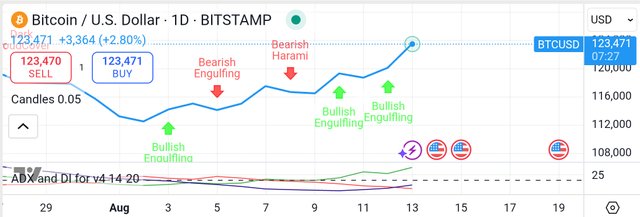1 BTC = $123,471 USD - What is a decentralized digital currency?
Bitcoin (BTC) is a decentralized digital currency established by the pseudonymous Satoshi Nakamoto in 2008. Technical analysis of its market movements has identified a Bullish Engulfing pattern. This suggests that the current positive momentum is likely to continue, indicating a bullish trend in the short term.
A core technical feature of Bitcoin is its finite supply, capped at 21 million coins. This scarcity is a hard-coded rule in the protocol. The ADX-DI indicator, which measures trend strength and direction, is in positive territory, further reinforcing the current upward trend and suggesting strong buying pressure.
Bitcoin's unique properties are derived from its cryptographic foundation. This security mechanism ensures that transactions can only be authorized by the rightful owner of the bitcoins, preventing unauthorized access and solving the double-spending problem, a critical issue for any digital currency.
About Bitcoin (BTC)
Bitcoin (BTC) is a decentralized digital currency created by an anonymous entity known as Satoshi Nakamoto in 2008. It operates on a peer-to-peer network without the need for a central authority like a bank or government. At its core, Bitcoin is a consensus mechanism for a distributed ledger technology, commonly known as a blockchain. This blockchain is a public, immutable ledger that records every transaction and is replicated across a global network of computers, called nodes.
Technical Features and Mechanisms
Bitcoin's unique properties are derived from its foundational cryptographic and consensus mechanisms.
⛓️ The Bitcoin Blockchain
The blockchain is a chain of data blocks, each containing a list of verified transactions. To add a new block, a participant (a miner) must solve a computationally intensive cryptographic puzzle using a process called Proof-of-Work (PoW). The solution to this puzzle, a hash that meets a specific difficulty target, is difficult to find but easy for other nodes to verify. This process ensures that no single entity can dominate the network or tamper with the transaction history. The difficulty of the puzzle automatically adjusts to maintain an average block creation time of roughly 10 minutes. This creates a secure, chronological record of transactions.
💰 Bitcoin Supply and Halving
A key feature of Bitcoin is its finite supply of 21 million coins. This scarcity is a hard-coded rule in the protocol. New bitcoins are introduced into the network as a reward to miners who successfully add a new block to the blockchain. This block reward is programmatically halved approximately every four years (or every 210,000 blocks) in an event known as halving. This deflationary mechanism is designed to mimic the scarcity of precious metals like gold, making it resistant to the inflationary policies often associated with fiat currencies.
🔐 Cryptographic Security
Bitcoin transactions are secured using public-key cryptography. When a user creates a transaction, they use their private key to create a digital signature. This signature proves ownership of the funds without revealing the private key. Other network participants can then use the corresponding public key to verify the signature's authenticity. This cryptographic security ensures that only the rightful owner can authorize a transaction, protecting against unauthorized spending and the double-spending problem, where a user could potentially spend the same funds more than once. The entire transaction history is transparently recorded on the blockchain for anyone to inspect.
Disclaimer: This is not financial advice; consult a qualified professional before investing, as cryptocurrencies and similar products carry significant risks.
Assisted by https://gemini.google.com/.
See also:
- Reversteem: merges the strategic thrills of classic Reversi with the decentralized power of Steem blockchain, letting you duel friends through blockchain-recorded games
- @steem.amal: Charity At Your Fingertips
- Maximize curation rewards: follow our trail! Maksimalkan reward kurasi: ikuti trail kami! トレイルをフォローし、キユレーション報酬を最大化!
- Pi Network - Crypto Pertama Yang Dapat Ditambang Di Ponsel
- Piネットワーク — スマートフォンでマイニングできる最初の暗号通貨

Upvoted! Thank you for supporting witness @jswit.